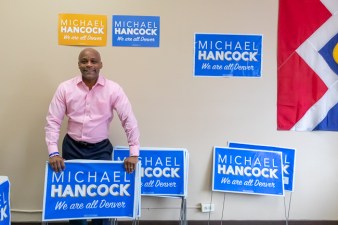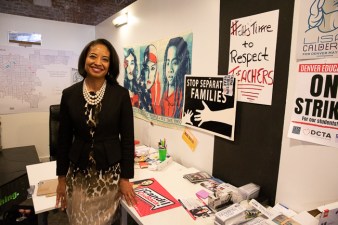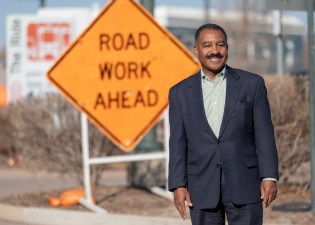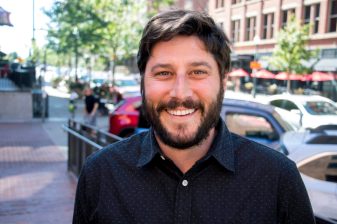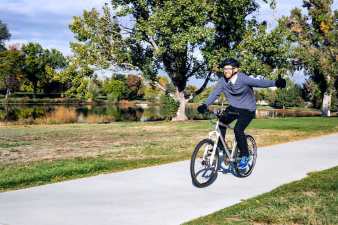Mayoral Candidate Jamie Giellis: The Streetsblog Interview

This is the second of a series of interviews with four candidates for Denver mayor in the May 7, 2019 municipal election. Editor Andy Bosselman conducted and condensed each interview. Several members of the Streetsblog Denver board of directors advised Bosselman in choosing the candidates and the subject matter covered. Other interviews include: Sen. Penfield Tate, Dr. Lisa Calderón and Mayor Michael Hancock and Kalyn Heffernan.
Jamie Giellis is the former president of the RiNo Arts District and a consultant who facilitates collaborations between neighborhood districts and local governments.
Disclosure: Real estate developer Kyle Zeppelin comes up in this interview. He is a former member of the Streetsblog Denver board.
Q: Briefly, what can you do for Denver voters that Mayor Hancock can’t?
A: Lead with vision, strategy, clarity and common sense — with a really collaborative approach.
I have been involved in both the policy side, and working on the ground, with nearly every department of the city. So I’ve got that experience. I’ve been in the weeds. I’ve been on the policy side, and I bring that to City Hall.
I feel like the mayor is a bit disconnected from the day-to-day. Disconnected to where the where the logjams are in the system and how we overcome that by getting to a culture of “yes,” of innovation, in all our different departments.
It’s very much what led me to get into the race: We’ve become a city that prioritizes why we can’t do things instead of why we can.
Q: What’s your vision for Denver’s transportation future?
A: Transportation is one of my biggest areas of focus and it’s a passion area for me. I envision a city and neighborhoods that are interconnected with a reliable, efficient and affordable network. My vision is partly connected to the past, and partly connected to inspiration from other cities around the world.
I think the fact that we were built on a streetcar network as a city, that streetcar network largely defined these wonderful neighborhoods, with the centers of these little commercial districts, is inspiration for me. How do we reconnect places and build communities through transit? And then [I’m] also inspired by the fact I’ve done a lot of work abroad. And I see in places like Europe and Asia how transit so effectively works to make a city work even better.
Q: Tell me about the last time you took public transportation.
A: I live right over here in Platt Park, just a couple of blocks off of the rail station there on Buchtel. Not sure when that was, probably within the last six weeks or so. We use that oftentimes to come downtown, or in the summertime to go to Rockies’ games.
I would love to take transit more. But the unfortunate thing is, unless you’re going to a place where there’s a stop, you always have that extra step. Once you get the station, if your destination isn’t within a walkable radius: Are you going to Uber to the next place? Are you going to rent a bike? That’s really the challenge that motivates me, I wish I could get on a rail and know that I could get anywhere in the city.
Q: Public transit works best when it’s near dense neighborhoods. When voters approved FasTracks in 2004, I remember that transit-oriented development was a major selling point. I saw renderings of dense neighborhoods centered around places like the former Gates Rubber factory. But 15 years later, that site is still empty. Union Station has become more dense. But Denver really hasn’t seen a lot of tall buildings and significant density built around transit. Would you change that? How?
A: Absolutely. I was recently involved with the most recent upzoning around rail at 38th and Blake in my role as president of the RiNo Arts District.
There was an acknowledgment that when that station opened, the height limits were still just eight stories. Was that really enough was enough density there?
We knew we would have to engage with all the neighborhood stakeholders around there to talk about going high because it is so close to historic neighborhoods. But we turned that into a win-win-win for everybody.
The communities seemed to be OK with the idea of density. But in return they also want affordability at the stations, and they want great design. They want the public realm aspect of that density to feel really good, and feel like it connects to the community.
It’s the first time ever it’s been done, we tied an upzoning to a density bonus. [It allows taller buildings in exchange for developers providing affordable housing, creating activated ground-floor commercial spaces and committing to design standards].
(The Denver Post reports that this development “has not materialized yet.”)
Q: In your time working with several organizations focused on the RiNo Arts District, do you have accomplishments related to pedestrian safety, bicycle infrastructure, or public transportation that you’re proud of?
In River North, when the Brighton Blvd. design first started, the city came to us and showed us a plan for streets that was essentially four lanes traffic. And that’s pretty much it. Basically another Colorado Blvd. We knew that the community valued walkability and bikability as part of that change. The city said to us, “There will never be bike lanes on Brighton Boulevard.” That was their first response.
So we went in and pulled in the community, and pulled in Bike Denver, Walk Denver. Ultimately, through community-driven process [we] got the city to say OK. And not only did they say OK, they ultimately ended up paying for it. It is today still the only street that has [a raised and protected bike lane.]
Q: You have said that you support the city’s Vision Zero goal to end all traffic fatalities and serious injuries by 2030. According to the Denver Streets Partnership, making the needed bike and pedestrian changes would take 100 years to achieve at current funding levels of about $5 million per year. Roughly $40 million per year is needed to meet the goal by 2030. You told All-In Denver that an additional $5 billion is also needed for transit. You said that you could raise this money with a small fee on every Uber and Lyft ride, a value capture tax along transit corridors, and a sales tax. Will those sources of funding be enough?
A: That $5 billion is the number proposed in the Denver Moves Transit plan. It’s a broad number. If we decided we’re going to do streetcar everywhere, or we’re only going to do bus rapid transit, or we’re just going to boost our bus network, that number would shift significantly.
[At this point in the interview, real estate developer Kyle Zeppelin passed through the room, Giellis said “Hi, Kyle.”]
In terms of funding, this is going to be the most complicated thing that a new mayor has to address. We know there’s going to not be one source.
[In Portland,] wherever they put their streetcar line, they created a special taxing district where they tax just those property owners on either side of the rail line, and they bonded against that. I don’t know if we can do more property tax here, people are pretty tapped out.
Sales taxes is another option and we haven’t run an analysis, I’ll be honest with you, on what sales taxes would generate. I think it’s probably our best option, but we also just passed a multitude of sales taxes in November.
Uber and Lyft is very hard to calculate right now because [the companies] don’t share data. So we have to get into a partnership with them to see what that would generate. The other options are things like putting a fee on vehicle registrations.
Ultimately, I think we’re going to be talking about a very complicated capital stack to get the money we need. … All to say, I don’t have all the answers right now.
Q: Your position on transportation says that Denver cannot count on RTD, that the city should create a Transportation Department and implement its own transit network. I see some potential problems with that:
- Creating a new transit agency would be costly, time-consuming and would compete for scarce drivers with RTD.
- It would force riders to learn how to use two different transit systems.
- Competing transit agencies typically duplicate service, which is costly
- If a rider needs to make a connection from say a bus on one system to a train on another, it’s can be difficult for competing systems to design schedules to make those transfers seamless.
- There would certainly be a different fare structure, monthly passes and electronic payment cards, too.
- But in Seattle and Boulder, city governments pay the regional transit system to supplement service within the cities, which eliminates many of these problems. There’s already talk of doing that in Denver. Why not do that?
A: There’s several things to consider here. Creating a Transportation Department is a charter change, so it has to go the people. So the best the mayor can do is put up a proposal to do that. [Hancock did that last week, proposing a Department of Transportation and Infrastructure, which could eventually allow the city create its own transit system.]
There are good arguments for both [supplementing service with RTD or creating a new transit agency]. There’s definitely a lot of improvements to be made in terms of how the mayor’s office works and coordinates with RTD.
Ultimately [RTD is] a regional board, who, if you talk with them, don’t always align with the local priorities of Denver.
We need our city to work for us. We need to have the ability to have good oversight of how that works for us.
Boulder might be able to get by with subsidies to increase service. But here we’re talking about a whole new network to connect our neighborhoods. Do we want the fate of how things operate to be in the hands of RTD, knowing that the best we have as a bully pulpit? And not a vote? Not a mayor’s vote to to change things?
Q: You have made the creation of a new streetcar network one of the key features of your candidacy. People like streetcars because they’re cool and they tend to boost nearby real estate prices. But with the exception of Portland, the lines built in the U.S. in the last decade have not been successful. They have low ridership because they were not designed with a clear focus on improving mobility. They are slow because they mix with street traffic. They don’t come frequently enough. And they haven’t tended to connect well with existing transit. How would your plans avoid these pitfalls?
A: [Outside of Portland,] I don’t know that many of those streetcar systems have been built out as actual comprehensive systems to serve the city as their core transit infrastructure. Streetcars have frequently been used as kind of a cool thing to connect one neighborhood to another … sometimes [it’s] as much about a tourist draw or a fun thing to do on the weekends.
Given what Portland has achieved … I think the streetcar is a totally viable option. There’s economic opportunity. If we can get the network right, and get the pricing [and] frequency right. I do believe it’s something people will use.
I also believe that we can be smart and innovative enough to figure out the [mixed traffic] situation.
Q: Cities usually compete for federal grants to build new transit infrastructure. Those grants tend to be awarded to projects that have a bigger impact than streetcars can offer, like Bus Rapid Transit. Would you expect to get federal funding for the streetcars? And would your focus on streetcars sacrifice existing projects in the works like Colfax BRT?
A: I would definitely still try to get federal funding. If you can make the argument that this is a comprehensive network, you can show that it can work as a true transit network.
The BRT project on East Colfax, for me, it comes down to: How will that network tie into any other network we’re going to create? Making one transit investment before you have a clear strategy for how you’re going to do transit throughout the city [raises an interesting question].
It seems a little bit backward to me. We should have a clear strategy. Like BRT everywhere, and that’s what we’re moving towards. [Or] streetcar everywhere, and that’s where we’re moving towards.
If I come into office in July, and we focused a lot of energy on laying out the system … and BRT is one piece that doesn’t make sense, or we can figure out how to do things better, connected into a bigger system, that would be a question to go back to all these people that have worked so hard on the BRT and see if it makes sense to rethink it. But I’m not committed one way or another. There’s too much work been put in it to say I’m going to scrap it.
Q: Kyle Zeppelin, whose support has been critical to your campaign, has an ax to grind with Mayor Hancock. At the candidate forum at the Alliance Center on March 21, you were seen going over your notes with him. If you’re elected mayor, what role will Zeppelin have, either formally or informally, in your administration?
A: I think that’s a bizarre question. First of all, I wasn’t going over any notes with him. He had shared with me a statistic he had heard on the radio on the way over about something which I don’t even remember.
He wouldn’t have any role in the administration, and that’s a completely silly question because I’ve got something in the vicinity of 400 donors to the campaign. All across the board, from neighborhood organization leaders to really successful small business owners. And everybody gets a seat at the table.
[The Zeppelin family has donated about $60,000 to Giellis’ run. The the campaign has raised a total of $400,000, according to the Denver Post. Today the Post also covered Mayor Hancock’s criticism of Kyle Zeppelin’s role in Giellis’ candidacy.]
[Giellis’ communications consultant Meghan Dougherty interrupts the interview and reframes the question, asking why Zeppelin supports her.]
Solely because of the work I’ve done in River North. And all the work I’ve done in my career, which is largely inspired by models that are … more driven by the philosophy of what we can do inspired by European models, which tend to be far more aggressive on transportation and sustainability. We’ve always had alignment there.
I think he has a vision for the city that is built on a bigger vision than we’ve seen right now and he believes I have the ability to do that because he’s seen that I did do it.
When people have talked about how I will appoint my appointees and boards and commissions, the one promise I’ve made is this will not be based on a “friends system.” This is going to be based on who’s prepared and qualified to lead.
Q: One of Zeppelin’s frustrations is the city’s denial of loan requests sought for his real estate projects. If he came to the city for additional loans, development on city land, or other special treatment, how would you handle it?
I don’t give any special treatment to anybody. Period. Never have. Never will.
Anything else you’d like Streetsblog readers to know?
I come from a background of having been raised in a small town where my dad was a small town mayor. The basic tenets of that approach were … about community and collaboration and common-sense solutions.
I pride myself on having been somebody that can work very closely with the city, and work very closely with community, and break through bureaucracy to get to actual implementation. Not always to the degree that we wish, but I find ways get things done.
You take that approach, and you put it at the head of a city that has every opportunity to be bold right now. You can move to a culture that is largely about how do we become not just like Seattle or Portland or Austin, but how do we become better than them? How do we become the best? That’s really what I’m going to do.
Streetsblog Denver informs the movement for sustainable transportation and a livable city. Give $5 per month.
